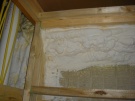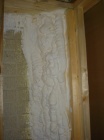
Spray Foam Insulation
Why use Spray Polyurethane Foam Insulation?
- Help for Allergy Sufferers
- Insulates Band Joist Areas
- Foam Insulation Adds Strength to Your Building
- Foam Insulation Saves Money
- Seals and Controls Air Infiltration
Build Energy Conservation into Your House or Commercial / Industrial Site
- Foam insulation is spray applied directly into stud cavities or other surfaces, sealing joints and cracks throughout the structure's outer framework.
- Spray polyurethane foam insulation expands and fills unwanted voids in the building envelope to stop air infiltration.
- Spray polyurethane foam insulation quickly cures to a rigid monolithic insulation that holds tight and helps make the structure stronger.
- Spray polyurethane foam's performance enhances the mechanical ventilation equipment's ability to provide a controlled, properly ventilated environment.
- A spray polyurethane foam system also seals and reduces the temperature differences between the outside and inside wall - preventing convection currents of air from looping up and down in the walls.
Use Foam Insulation to Minimize Condensation Concerns
Homes and commercial buildings are designed to be tighter with more insulation value than ever before. Moisture from cooking, laundry, showers and industrial applications can be trapped, causing premature deterioration of the structure. Spray polyurethane foam insulation systems minimize both heat buildup and condensation, resulting in cooler and dryer attics in all climates.
The Insulation R-Value Myth
"R" refers to resistance to heat flow. These measurements are taken in a laboratory environment. But heat flow resistance is only part of the formula for effective insulation. R-value doesn't measure the amount of air infiltration or moisture that penetrates through an insulated wall. In short, the measurement doesn't factor in real-world weather conditions. The only way to eliminate air infiltration and moisture is to completely seal the building and use mechanical air controls to regulate air flow.
Features |
Benefits |
|---|---|
Polyurethane Foam Has High Insulation Value |
|
Foam Insulation Stops Air Infiltration |
|
| Foam Insulation is Moisture Resistant |
|
Foam Insulation is Spray Applied |
|
Foam Insulation is Rigid |
|
Foam Insulation is Lightweight |
|
Foam Insulation has Excellent Adhesion |
|
Polyurethane Foam Insulation is Safe |
|
Foam Insulation is Code Approved |
|




